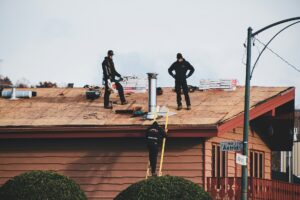A roof replacement can feel like a big undertaking. Not only is your home’s exterior exposed for the duration of the project, but it’s also noisy, busy, and involves an array of materials and professionals coming in and out of your property. Yet replacing an older or damaged roof is one of the best investments you can make in your home, helping safeguard everything inside from leaks and weather damage for years to come. Knowing precisely what to expect from planning to teardown to final inspections can help you prepare for temporary disruptions and better understand the work being done. Here’s a comprehensive look at each phase in a typical roof-replacement process, including how to make sure you and your family are ready for the transformation.
Early Planning and Assessments
Budgeting and Estimates
- Gather Multiple Quotes: Start by reaching out to at least three reputable contractors for detailed estimates. Ask each to conduct an on-site inspection and provide an itemized quote.
- Compare Scope, Materials, and Warranties: Don’t select a roofer based solely on the lowest bid—look at the materials they recommend, their experience, and whether they include a workmanship warranty.
- Budget for Unexpected Repairs: Hidden damage is frequently discovered once the old shingles come off. Setting aside an extra 10%–20% of your budget for contingencies can help you avoid surprises later.
Roof Inspection
- Professional Evaluation: Your chosen roofer or inspector will climb onto the roof (or use a drone) to look for worn-out shingles, damaged flashing, or rotted decking.
- Attic Check: Sometimes, the attic reveals moisture stains, ventilation blockages, or mold growth, all of which might need attention before or during a replacement.
- Local Regulations: Confirm local building codes and whether you need a permit for a full replacement. In many municipalities, you cannot have more than two layers of shingles, so that’s something a contractor will verify.
According to the National Roofing Contractors Association, routine inspections and properly planned replacements can extend your roof’s life and improve performance significantly.
Pre-Project Preparations
Choosing Materials and Colors
- Asphalt Shingles Dominate: They’re the most common due to affordability, availability, and reliable performance. Within this category, architectural shingles offer added thickness and dimension.
- Metal, Tile, or Wood: In some regions, metal roofing is popular for energy efficiency and longevity, while clay tile suits warmer climates. Wood is coveted for its rustic look but demands more maintenance.
- Color Coordination: Consider your home’s siding, trim, and environment to pick a color that complements the overall design. Darker shingles absorb more heat, while lighter shades reflect sunlight—a factor in energy usage.
Scheduling and Logistics
- Timeline Expectation: Most average-sized residential reroofs can typically be done in two or three days, though complex roofs may take a week or more.
- Weather Watch: Storms or extreme temperatures can cause delays. Flexibility with start and end dates ensures quality workmanship.
- Permits and Approvals: If you’re part of a homeowners’ association (HOA), get the required sign-off on color, style, and scheduling. The roofing contractor typically pulls local permits, but confirm that it’s included in your contract.
Preparing Your Home and Family
- Clear Your Driveway: Roofing trucks and dumpsters need easy access. Move your cars and clear out yard furniture or potted plants near the exterior walls so they won’t be in the way or risk damage.
- Secure the Interior: While the crew isn’t typically in your home, vibrations and hammering can knock items off shelves or walls. Remove fragile décor from walls, especially on the upper floors or attic areas.
- Plan for Noise and Pets: Contractors usually start early—7 or 8 a.m.—so expect hammering, nail guns, and loud conversation during work hours. If you have pets, consider keeping them in a quieter area of the home or arranging off-site care on especially busy or noisy days.
Tear-Off and Removal of Old Materials
Removing Existing Roofing
- Full Tear-Off vs. Overlay: Most professionals recommend tearing off old shingles to inspect the roof deck thoroughly. Some building codes allow a second layer, but this approach can hide problems like trapped moisture.
- Disposal Logistics: Generally, roofers bring a roll-off dumpster to your property. All old shingles, nails, and underlayment go directly in. If you have eco-friendly disposal options in your area, the crew might recycle asphalt shingles.
- Protecting Your Yard: Reputable roofing contractors often use tarps to shield landscaping and catch falling debris. It’s wise to cover delicate flowers or shrubs or ask the crew for extra caution around those areas.
Revealing the Decking (Sheathing)
- Deck Inspection: Once the old materials are off, it’s time to check the wood sheathing for damage like rot or mold. If some panels are soft or discolored, your roofer will replace them before adding new underlayment.
- Adding or Updating Ventilation: If you plan to improve airflow in the attic (via ridge vents or additional soffit vents), this is the stage when the structure can be opened up and retrofitted.
- Additional Repairs: In older homes, you might discover code violations or out-of-date flashing around chimneys, skylights, and vents. The next step is addressing these issues so the new roof installation meets today’s standards.
Installing the New Roofing System
Underlayment and Ice/Water Shield
- Synthetic or Felt Underlayment: After any decking repairs, roofers roll out an underlayment layer. Synthetic underlayments are increasingly popular due to better tear resistance and water shedding compared to traditional felt.
- Ice and Water Shield: In colder climates, a contractor may install a special waterproof membrane along roof edges, valleys, and penetrations to prevent ice dams or wind-driven rain from backing up under the shingles.
Flashing and Drip Edges
- Replacing Old Flashing: Flashing is critical for sealing around chimneys, dormers, skylights, or sidewalls. Good roofers never reuse old or damaged flashing—installing new, correctly sized pieces ensures watertight transitions.
- Drip Edge: A narrow metal strip along eaves and rakes helps guide water into gutters and away from the fascia, extending your roof’s life. Many building codes now require drip edges to reduce water intrusion.
Shingle or Panel Installation
- Working Methodically: Roofers typically start at lower edges, using chalk lines or guides to ensure consistent, straight elevation of shingle rows.
- Nailing Patterns and Overlaps: Each shingle is nailed in place following manufacturer specs for spacing, approach, and nail type, ensuring the warranty remains valid.
- Health and Safety: It’s common to see harnesses, toe boards, or scaffolding on steeper roofs. The crew should have safety protocols, especially when climbing or removing heavy materials.
Ridge Caps and Finishing Touches
- Capping the Roof: Once the main field shingles or panels are in place, the crew installs ridge caps, vents, or other finishing elements at the roof’s peak.
- Detailing Around Skylights and Other Features: This is a time-consuming but necessary step to prevent water infiltration. Proper sealing and flashing in these intersections ensures a durable, leak-free system.
- Clean-Up: Professional teams typically tidy up as they go, but expect a final sweep with magnetic rollers to pick up stray nails. A neat job site is a good indicator of the crew’s attention to detail.
According to This Old House, installing new flashing properly is one of the most critical factors in preventing leaks. Good technique here pays dividends down the road.
Unexpected Issues and How They’re Handled
Discovering Rotted Decking
- Common in Older Roofs: Decades of leaks or insufficient ventilation can rot the wooden sheathing beneath shingles. Replacing these panels ensures your new roof base is sturdy and code-compliant.
- Extra Cost: You’ll often see an add-on fee per sheet or square foot. This highlights why you should budget a contingency fund.
Water or Mold Damage
- Attic Mold: Poor ventilation can trap moisture, promoting mold. If mold is discovered, you may need specialized cleaning or remediation to keep spores from spreading.
- Structural Repairs: If rafters, trusses, or joists have serious damage (e.g., termite infestation or severe rot), partial structural replacements might be required. This can extend the timeline significantly.
Code Upgrades
- Local Building Requirements: Sometimes, older flashings or minimal attic insulation no longer meet current code or fire safety standards. Upgrades like adding more insulation (if you’re switching to an unvented roof design) or installing step flashing near walls could be mandatory.
Quality Checks and Final Inspections
Contractor’s Inspection
- Walkthrough: Once the work is done, expect your contractor to examine the entire roof—checking shingle alignment, splash guards, flashing, vents, and overall workmanship.
- Punch List Items: If minor issues surface—like a missed seal around a pipe vent or a misaligned ridge cap—the team should address these before handing you the final invoice.
Building Department or Third-Party Inspection
- Permit Requirements: In many jurisdictions, a code officer or inspector must officially sign off on the work. If your permit demands it, the inspector may climb up or use binoculars from the ground for a quick check.
- Passing Results: If everything’s up to code, you’ll receive a certificate or formal confirmation that the replacement meets local regulations.
Testing Gutters and Downspouts
- Quick Water Test: Some roofing pros do a quick test to ensure gutters flow properly, especially if you replaced them or added new downspouts during the project.
- Maintenance Tips: Your contractor can offer guidance on gutter cleaning schedules and ways to keep large debris from clogging channels—crucial if you have new drip edges or a different shingle overhang.
Cleanup and Project Completion
Site Cleanliness
- Rolling Magnet Sweep: An effective roofing crew will move a magnet bar around your yard, driveway, and landscaping to pick up stray nails.
- Dumpster Removal: The roll-off dumpster typically leaves a day or two after the roof is finished, ensuring all debris disposal is handled in one go.
- Final Yard Walkthrough: Take a look around the property to confirm no loose materials (like small scraps of underlayment) or leftover shingles remain.
Ongoing Maintenance
- Understanding Your Warranty: Most roofing materials have both a product warranty (covering manufacturing defects) and a workmanship warranty from the installer. Keep all documentation in a safe place.
- Annual Inspections: Even a new roof benefits from periodic checks—especially after severe weather. Promptly addressing tiny problems, like cracked caulk or loose flashing, helps preserve your roof’s condition over the long term.
- Gutter and Vent Care: Clear gutters and check vents regularly to ensure optimal airflow and moisture control in the attic. This also helps stave off potential ice dams in colder climates.
Living Through the Replacement: Practical Tips
Minimizing Disruption
- Early Starts Are Normal: Crews prefer cooler morning temperatures. If you or family members need quiet time, coordinate with the roofer for any scheduling requests—though heavy machinery and hammering can’t be entirely avoided.
- Children and Pets: Keep them safely indoors, away from the action. Inquisitive kids might be tempted by ladders and equipment.
- Protect Vehicles: Park your car away from the house to guard against dust or falling shingles. Even if your driveway is clear, debris or roofing nails can cause tire punctures.
Communication with Neighbors
- Give a Heads-Up: Let neighbors know about your start date, estimated project length, and potential noise.
- Inform Them of Any Shared Property Lines: If the roofing crew needs access, or if debris might fall near a fence or bushes, ensure your neighbors are aware. Friendly communication can prevent misunderstandings.
Contingency Plans
- Weather Delays: Understand that sudden rain or gusty winds might halt work. This ensures all roofing layers remain protected, preventing water from seeping into your attic mid-project.
- Lodging for Special Cases: If you’re extremely sensitive to noise, or if kids have important exams or toddlers’ nap times, you might consider staying with relatives or at a hotel for key tear-off days.
Common Myths vs. Reality
“They Can Finish in a Single Day—No Exceptions”
- Reality: Some smaller roofs do finish in one day, especially if you have a straightforward design and minimal damage. But many standard to large-scale projects take multiple days, especially when factoring in potential unforeseen repairs.
“Noise Won’t Be That Bad”
- Reality: Roof replacement is loud. Between hammering, nail guns, shingle removal, and disposal, you’ll notice the clatter for hours. If you work from home or have noise sensitivities, plan accordingly.
“I Won’t Need to Replace My Gutters or Vents”
- Reality: While not always mandatory, older gutters and vents sometimes show wear. Replacing them while the roof is off can be cost-effective and ensures a cohesive, properly sealed system.
Real-World Example
Consider a homeowner named Mark who’d put off a roof replacement for several years. During his initial inspection, the contractor discovered signs of water infiltration around the chimney. Here’s what happened:
- Mark scheduled the project in early summer, aiming for clear weather.
- The crew arrived with a dumpster in the driveway and tarped the surrounding landscaping. Tear-off revealed rotten decking in three spots—an unforeseen cost, but Mark had set aside a contingency budget.
- Over four days, Mark dealt with consistent daytime noise and let his neighbors know about the timeline. He took advantage of the final day by planning a short family trip so they wouldn’t be home for the noisiest hours.
- Once the project wrapped, Mark walked his property to confirm no nails or shingle debris remained.
- The end result: A brand-new architectural shingle roof with improved attic ventilation around the chimney. Mark’s contractor provided a 10-year workmanship warranty and a 30-year product warranty on the shingles.
The entire process left Mark relieved and confident he’d protected his home from future leaks—despite it being a bit loud and dusty during active installation.
Wrapping Up: Ensuring a Successful Roof Replacement
A roof replacement is a substantial, multi-step project that requires careful planning, open communication, and a realistic view of the potential noise and disruptions. By selecting quality contractors, budgeting for unknowns, and maintaining a safe, accessible work area, you’ll set your roof replacement up for success.
- Plan your timeline according to weather and personal schedules.
- Prepare your home—inside and out—to minimize accidental damage or inconvenience.
- Understand that minor complications or delays are common, but a professional roofer should keep you updated on progress.
- Save all your warranties, receipts, and pictures for your records (and for any potential future home sale).
A professionally installed roof can last 20, 30, or even 50 years, depending on the material. With proper maintenance, it will keep your home dry, comfortable, and structurally sound while adding to your home’s curb appeal and long-term resale value. By knowing exactly what to expect and taking proactive steps during each phase—from tear-off to inspection to cleanup—you and your family can navigate the process with minimal stress and maximum payoff.
Additional Resources
- National Roofing Contractors Association – Best practices, roofing safety guides, and contractor resources.
- This Old House: Roof Replacement Tips – Insightful articles and how-to videos on roofing options.
- Energy.gov on Roof Ventilation – Guidance on ventilation for energy efficiency.




